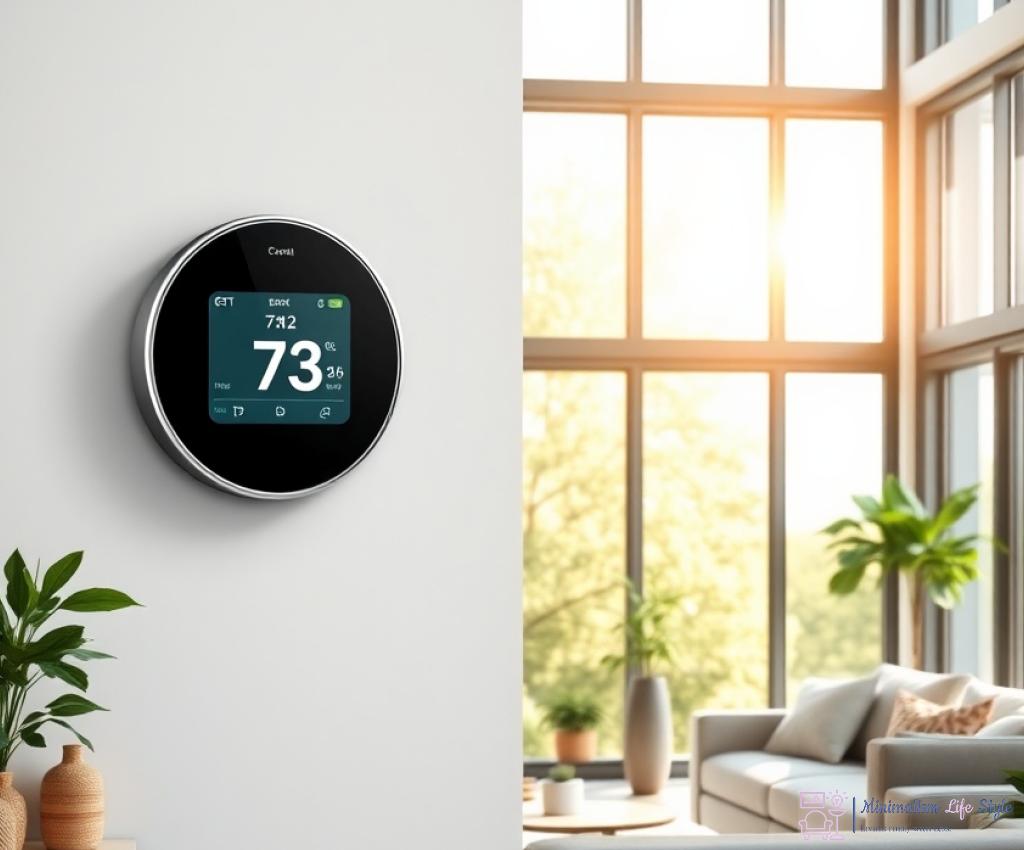The Rise of Smart Thermostats: A Greener Future

As the world increasingly recognizes the importance of sustainability, smart thermostats are emerging as a pivotal technology in the quest for energy efficiency. These innovative devices not only offer convenience but also significantly reduce energy consumption. Homeowners are discovering that by integrating smart thermostats into their living spaces, they can manage temperature settings intelligently, leading to a notable decrease in energy bills and a smaller carbon footprint.
Smart thermostats are more than just digital replacements for traditional models. They come equipped with advanced features that allow them to learn your habits and preferences, enabling them to make real-time adjustments to heating and cooling systems. This sophistication translates into substantial energy savings and a more comfortable living environment.
To better appreciate their impact, consider the following features:
- Adaptive Learning: Smart thermostats analyze your daily routines and adjust temperatures accordingly, ensuring you’re comfortable when you’re home and saving energy when you’re away.
- Remote Access: With mobile apps, users can control their home’s temperature from anywhere, allowing for adjustments on-the-go.
- Energy Reports: Many models provide insights into energy usage, helping homeowners understand their consumption patterns and identify areas for improvement.
- Integration with Smart Home Systems: Smart thermostats can seamlessly connect with other smart devices, creating a cohesive and efficient home environment.
In addition to personal benefits, the adoption of smart thermostats plays a crucial role in broader environmental efforts. By optimizing energy usage, these devices contribute to reduced greenhouse gas emissions. A single smart thermostat can save an average of 10-12% on heating and 15% on cooling costs, translating into significant savings on energy consumption.
To illustrate the potential impact, consider this table showing estimated energy savings from smart thermostat usage:
| Thermostat Type | Annual Energy Savings (%) | Carbon Emissions Reduction (lbs/year) |
|---|---|---|
| Traditional Thermostat | 0 | 0 |
| Basic Smart Thermostat | 10-12 | 1,000 |
| Advanced Smart Thermostat | 15 | 1,500 |
As more households make the switch, the cumulative effect can lead to a substantial reduction in energy consumption and emissions on a community and global scale.
Energy Efficiency: Cutting Costs with Minimalism
As we embrace a lifestyle that values simplicity and sustainability, the concept of green minimalism is becoming increasingly relevant in our daily lives. In the realm of home heating and cooling, smart thermostats have emerged as a cornerstone of energy efficiency. By optimizing temperature management, these devices not only help reduce energy consumption but also align with the minimalist ethos of cutting unnecessary costs and clutter from our lives.
In the pursuit of a more energy-efficient home, it’s important to recognize how minimalism can help streamline our thermostat usage. By focusing on essential features and practices, homeowners can enjoy considerable savings while also contributing positively to the environment.
Smart thermostats are designed to do more than just maintain a comfortable temperature; they are equipped with features that promote energy efficiency and cost savings. By utilizing these transformative functionalities, users can effectively cut down on their energy bills while embracing a minimalist lifestyle.
- Customized Scheduling: Rather than keeping the heating or cooling system running in the background, smart thermostats allow users to set schedules that adapt to their daily routines. This means temperatures are only adjusted when necessary, translating to significant savings.
- Geofencing Technology: By using location data from your smartphone, smart thermostats can automatically adjust the temperature when you leave or return home, ensuring energy is not wasted when you’re away.
- Energy Usage Insights: Many smart thermostats provide detailed reports on energy consumption, enabling homeowners to identify peak usage times and make informed decisions on how to reduce costs.
In addition to the technological advantages of smart thermostats, adopting minimalist practices can further enhance energy efficiency in the home. By prioritizing simplicity and functionality, homeowners can create a more sustainable living environment.
Here are some effective minimalist practices to consider:
- Declutter Your Space: A tidy home can lead to better airflow and temperature regulation. Remove unnecessary items from rooms to improve energy efficiency.
- Invest in Quality Over Quantity: Rather than accumulating multiple devices, invest in high-quality smart thermostats that deliver advanced features and reliability.
- Embrace Natural Elements: Use natural ventilation and sunlight to regulate temperature before relying solely on heating and cooling systems. This not only saves energy but also creates a more pleasant home atmosphere.
By integrating smart temperature management with the principles of green minimalism, homeowners can significantly cut costs while fostering a more sustainable lifestyle. The future of energy-efficient living is not just about technology; it’s about making mindful choices that lead to a healthier planet and a happier home.
Design Meets Function: Aesthetic Smart Thermostat Options
In an era where sustainability and aesthetics go hand in hand, the design of smart thermostats has evolved significantly. Homeowners are increasingly drawn to devices that not only perform well but also complement their interior decor. The marriage of form and function in smart thermostat design is a testament to the growing trend of green minimalism, where every aspect of a home reflects a commitment to both style and sustainability.
Modern smart thermostats are crafted with an eye for aesthetics, offering homeowners a choice of sleek and stylish models that can enhance the ambiance of any space. These devices come in various shapes, sizes, and finishes, allowing them to blend seamlessly into diverse home styles, from contemporary to traditional. By selecting a smart thermostat that aligns with your home’s design ethos, you can maintain an energy-efficient environment without sacrificing style.
The most appealing aspect of aesthetic smart thermostats is their ability to elevate home décor while delivering superior performance. With options that feature minimalist designs, touch screens, and customizable interfaces, these devices become an integral part of the living space rather than mere functional tools. The use of high-quality materials, such as brushed metal or glass, further enhances their visual appeal, making them an attractive addition to any room.
Notably, some models offer customizable colors and displays, allowing homeowners to adjust the thermostat’s appearance to match seasonal decor or personal preferences. This feature not only promotes engagement with the device but also encourages users to interact with their home’s temperature in a more conscious manner. By aligning design with functionality, these thermostats help to cultivate a sustainable lifestyle that aligns with the principles of green minimalism.
The integration of aesthetics with advanced technology does not compromise energy efficiency; rather, it enhances it. Many aesthetically pleasing smart thermostats are equipped with advanced features that contribute to energy conservation. For example, they include adaptive learning capabilities and geofencing technology, allowing them to optimize energy usage without requiring constant manual adjustments.
Furthermore, the impact of these devices on the environment should not be overlooked. By choosing a stylish, high-performance smart thermostat, homeowners can significantly reduce their energy consumption while also making a statement about their commitment to sustainability. The table below illustrates how aesthetic smart thermostats perform in terms of energy savings compared to traditional models:
| Thermostat Type | Annual Energy Savings (%) | Design Features |
|---|---|---|
| Traditional Thermostat | 0 | Basic, Functional |
| Aesthetic Smart Thermostat | 10-15 | Sleek Design, Customizable Display |
Incorporating an aesthetic smart thermostat into your home not only reflects a commitment to energy efficiency but also aligns with the principles of green minimalism. These devices serve as a reminder that sustainability and style can coexist, creating a harmonious living environment that prioritizes both comfort and design.
Data-Driven Comfort: Leveraging Insights for Better Living
In the evolving landscape of home automation, the intersection of data and comfort is creating a paradigm shift in how we approach temperature management. Smart thermostats are not just automated devices; they are insightful tools that harness data to enhance our living experiences. By analyzing patterns and preferences, these devices empower homeowners to make informed decisions that result in optimal comfort and energy savings, all while supporting the principles of green minimalism.
Harnessing the Power of Data is at the core of what makes smart thermostats exceptional. They are equipped with sensors and analytics that track various environmental factors, such as occupancy, temperature fluctuations, and even weather forecasts. This data is processed to create a personalized heating and cooling schedule that aligns perfectly with your lifestyle, ensuring that energy is used efficiently without compromising comfort. For instance, by understanding when you typically arrive home and adjusting the temperature accordingly, smart thermostats can minimize energy use during unoccupied hours, leading to significant cost savings.
Moreover, the ability to access real-time insights through mobile applications transforms the way homeowners interact with their living environments. Users can view energy consumption reports, identify peak usage times, and receive tailored recommendations for further energy reduction. This not only enhances awareness of energy habits but also encourages proactive adjustments that align with sustainable living goals.
Engaging with Energy Reports can significantly elevate the user experience. When homeowners can visualize their energy consumption patterns, they become more attuned to their usage behaviors, often leading to more conscious decisions regarding energy management. For example, if a user notices high energy expenditure during specific times of the day, they can adjust their thermostat settings or explore alternative energy-saving strategies. The table below illustrates how informed decisions can lead to substantial savings over time:
| Energy Usage Scenario | Annual Energy Savings (%) | Potential Cost Savings ($) |
|---|---|---|
| Regular Adjustments Based on Insights | 15-20% | $180 |
| Manual Adjustments Without Data | 5-10% | $60 |
In a world where sustainability is paramount, the integration of data-driven insights into smart thermostat usage is a game changer. It not only fosters a more energy-efficient lifestyle but also resonates with the values of green minimalism. By leveraging the data available at our fingertips, homeowners can ensure that their living spaces remain comfortable, stylish, and environmentally friendly, all while contributing to a more sustainable future.
The Environmental Impact: Reducing Your Carbon Footprint
In an age where climate change is at the forefront of global conversations, the choices we make in our homes can have a profound effect on the environment. Smart thermostats, as a key component of green minimalism, not only enhance our comfort but also play a vital role in reducing our carbon footprint. By optimizing energy usage, these devices help us make significant strides toward a more sustainable lifestyle, aligning our daily habits with the urgent call for environmental responsibility.
The transition to smart thermostats marks a pivotal shift in how we consume energy in our homes. Unlike traditional systems that operate on a fixed schedule, smart thermostats utilize advanced technology to adapt to our unique routines and preferences. This adaptive functionality leads to less energy waste, particularly during peak hours when energy demand is high. By leveraging features like adaptive learning and geofencing, homeowners can ensure that their heating and cooling systems are only active when necessary. This not only conserves energy but also contributes to a reduction in the overall demand for electricity, which is often generated from fossil fuels.
The environmental benefits of smart thermostats extend beyond mere energy savings; they translate into measurable reductions in carbon emissions. For instance, research indicates that households equipped with smart thermostats can save up to 15% on cooling costs and around 10-12% on heating expenses. When these figures are scaled to a community level, the impact becomes even more significant. The table below illustrates the potential annual savings and corresponding reductions in carbon emissions that smart thermostat users can achieve:
| Thermostat Type | Annual Energy Savings (%) | Carbon Emissions Reduction (lbs/year) |
|---|---|---|
| Traditional Thermostat | 0 | 0 |
| Basic Smart Thermostat | 10-12 | 1,000 |
| Advanced Smart Thermostat | 15 | 1,500 |
Imagine the cumulative effect if millions of homes adopt these technologies. This collective action can lead to a *substantial* decrease in greenhouse gas emissions, fostering a healthier planet for future generations. In essence, smart thermostats are not just devices; they are catalysts for change, empowering us to take actionable steps toward sustainability.




